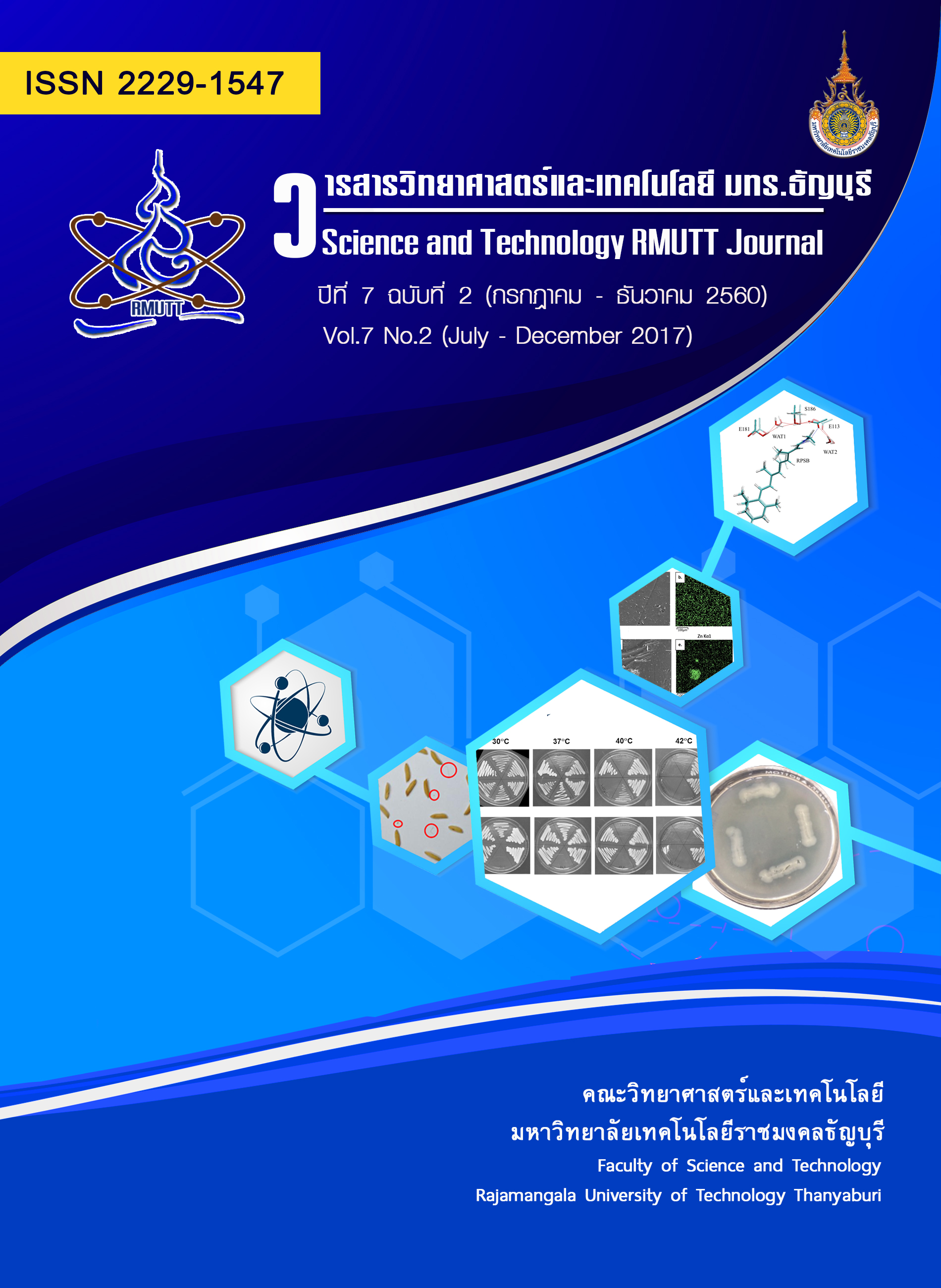The Turmeric in Cotton yarns dyeing by using Pisang Awak banana rubber as the mordant
Main Article Content
Abstract
In this research aimed to study the Turmeric dyed extraction process for using in dyeing the cotton yarns, cooperated with the Pisang Awak banana rubber as the mordant and to study in the optimum conditions in this dyeing process. In the Turmeric extraction process, water and ethanol used in extraction this dyed. After the wavelength investigated by UV-VIS spectroscopy found that the Turmeric ethanol extracted solution had a maximum absorption wavelength at 426 nm. The mordant, the Pisang Awak banana rubber, had used in different time of dyeing cotton yarns process (before, during and after) with Turmeric ethanol extraction. Moreover the different in temperatures (30 oC, 50 oC and 70 oC) and different time (30, 60 and 90 min) in dying process had studied. The optimum conditions was put the cotton yarns in the Pisang Awak banana rubber before dying in Turmeric ethanol extracted solution at 70 oC and 90 min, which the best dye absorption at 0.19 gram per the weight of the cotton yarns. After color fastness, washing test had undertaken, which using a standard detergent. The color of dyed cotton yarn were compared with the standard Grey Scales color plate. The findings was the cotton yarns color fastness tolerance to wash was at level five. This meant the dyed cotton yarn from Turmeric ethanol extracted dye has a high durable color strength value in washing with a code 2.5 Y 6/8. In the other hands, the study of the cotton yarns which dyed with Turmeric water extracted found that the mordant, the Pisang Awak banana rubber, could put in the solution after dying with Turmeric water extracted at 70 oC and 30 min. The color fastness tolerance to wash test was in the level five, means a high durable color strength value in washing with a code 2.5 Y 7/10 as well.
Article Details
References
ศศิกานต์ ปานปราณีเจริญ. การศึกษาสภาวะการย้อมสีขมิ้นบนด้ายฝ้าย. คณะวิทยาศาสตร์และเทคโนโลยี มหาวิทยาลัยราชภัฏเพชรบูรณ์. 2553.
Melgosa, R., M. Cruz, A. and Buitron G. Anaerobic/Aerobic Treatment of Colorants Present in Textile Effluents. Water Science and Technology. 5, 149, 2004.
Sriwai Kanhathathaisong, Saowanee Rattanapaphanee,Vichitr Rattanaphanee and Thanaporn Manyum. A Spectroscopic Investigation of the Complex of Turmeric Dye with Copper (II) in aqueous Solution. Suranaree J. Sci. Technology. 18. 159. 2011.
สรรพคุณกล้วยน้ำว้า. [ออนไลน์]. เข้าถึงได้จาก http://www.karnkaset.com/index.php? p=1&s=1&m = 6&i=66. (2556)
ชัยวัฒน์ แก้วคล้ายขจรศิริ. การศึกษากระบวนการผ้าย้อมครามโดยใช้ยางกล้วยน้าว้าดิบเป็นสารช่วยติด. วารสารวิชาการ ศิลปะสถาปัตยกรรมศาสตร์ มหาวิทยาลัยนเรศวร (ปีที่ 3 ฉบับที่ 1). หน้า 9. 2555.
พิมพ์ธิชา ยิ้มสาระ. ผ้าสวยด้วยยางกล้วยหลากสี. วิทยาลัยการอาชีพนครไทย อาชีวศึกษาจังหวัดพิษณุโลก. 2556.
อนุรักษ์ คำฟู. ย้อมสีธรรมชาติ. ศูนย์ส่งเสริมอุตสาหกรรมภาคที่ 1 จังหวัดเชียงใหม่. 2556.
จารุวรรณ ดิศวัฒน์. การย้อมผ้าไหมด้วยสีจากขมิ้นชันแห้ง. สาขาคหกรรมศาสตร์ ภาควิชาคหกรรมศาสตร์. 2546.
นฤมล ศราธพันธุ์. การใช้สารช่วยติดในการย้อมไหมด้วยขมิ้นชัน. คหกรมศาสตร์มหาบัณฑิต สาขา คหกรรมศาสตร์ มหาวิทยาลัยเกษตรศาสตร์. 2533.
M.M. Kamel, El Zawahry, N.S.E. Ahmed and F. Abdelghaffar. “Ultrasonic dyeing of cationized cotton fabric with natural dye”. Part l: Cationization of cotton using Solfix E. Ultrasonics Sonochemistry. 16, 243-249. 2011.
M.M. Kamel, Reda M. El-Shishtawy, B.M. Youssef and H. Mashaly. “Ultrasonic assisted dyeing. IV. Dyeing of cationised cotton with lac natural dye”. Dyes and Pigments. 73, 279-284. 2007.
Montra Chairat, Saowanee Rattanaphani, John B. Bremner and Vichitr Rattanaphani. “Adsorption kinetic study of lac dyeing on cotton”. Dyes and Pigments. 76, 435-439. 2008.
Padma S. Vankar, Rakhi Shanker and Jyoti Srivastava. “Ultrasonic dyeing of cotton Fabric with aqueous extract of Eclipta alba”. Dyes and Pigments. 72, 33-37. 2007.

